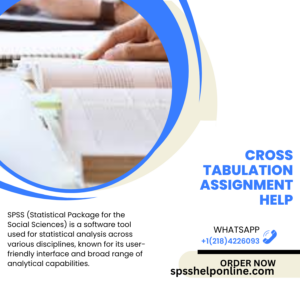Need someone skilled in SPSS for cross tabulation?
Need someone skilled in SPSS for cross tabulation? Create a cross tabulation of several Microsoft Office documents: Many documents support the combination ” ” and

Cross-Tabulation is a statistical technique for examining survey data. This analysis technique helps researchers uncover patterns, trends, and correlations within their studies.
Without proper analysis, data is useless; even the highest-rated surveys may produce little insight. That’s where cross-tabulation comes into play – providing the key insight that’s often missing from traditional analysis techniques.
Cross tabulation assignments can help transform raw survey data into meaningful insights that streamline decision-making processes and enhance decision making processes. Cross tabulation is an indispensable analytical tool, whether your aim is to unearth hidden patterns in customer feedback or shorten product development cycles.
Cross tabulation involves creating a table with rows and columns representing various variables. By looking at how frequently different categories appear together and their counts fluctuating within this table, cross tabulation enables researchers to examine how variables interact.
Cross tabulation can help you understand how customers perceive your Product by comparing answers across variables like age and gender. This allows you to see if there are any variances between how different people see your product as well as any correlations among variables.
Before performing a cross tabulation analysis, it’s essential to set clear research questions and objectives. These will assist in selecting variables and interpreting results correctly. You will also need to prepare the data for cross tabulation by cleaning and codifying variables appropriately – usually using statistical software designed specifically for this type of analysis.
Along with selecting and tabulating variables, you must also calculate frequency counts and percentages of each category to help identify whether there’s an significant relationship between your variables. For instance, cross tabulation enables researchers examining product satisfaction survey responses can use cross tabulation to examine any discrepancies between male and female respondent satisfaction levels.
This information will give you a deeper understanding of your data, allowing for informed business decisions as well as Studying demographics and social phenomena.
Cross tabulation allows you to simplify large data sets by breaking them down into representative subgroups, thus minimizing potential for errors while providing deeper insights from your Survey Results.
By conducting a customer satisfaction survey and comparing its results against demographic variables such as age, gender and location, for instance, you could discover that younger customers tend to prefer your products more than older customers – providing valuable insight that you can use to tailor future offerings more closely.
Cross-tabulation makes it easy to identify patterns in your data set without wading through raw numbers, making accurate predictions easier and Improving overall strategy. Furthermore, cross-tabulation helps determine whether a pattern is statistically significant – saving both time and money; misinterpreting a survey result could result in unnecessary investments such as keeping unpopular products on stock while incurring storage fees.
Cross tabulation can help make managing and interpreting raw survey data simpler, especially when working with large sets. By sorting through survey responses to identify meaningful patterns that support decision-making processes.
To understand a cross tabulation table, it’s essential to pay close attention to both rows and columns in each cell. Look out for patterns such as Higher Frequencies or percentages in certain combinations that could signal relationships among variables you are studying – for example if most males prefer blue over red this could suggest an association between gender and color preference.
This statistical analysis technique can be utilized across a range of industries. Customer service managers, for instance, may employ it to examine customer ratings for their company and improve services accordingly; similarly educators use it to measure instructor and student performance and discover weaknesses within curriculums; plus it assists businesses in recognizing market opportunities and refining Strategies.

Cross tabulation provides essential data analysis tools that enable meaningful changes and interventions, making for a valuable change process.
Imagine using massive oil refineries to convert crude into something useful; similarly, Statistical Analysis transforms raw survey responses into useful tables of data that allow you to examine relationships systematically.
Cross tabulation (commonly referred to as contingency tables) is an indispensable statistical tool used in market research studies and surveys for analysing categorical data. Cross-tab reports (sometimes also known as contingency tables) help uncover relationships that might not be readily evident from looking at total survey responses, for instance between age preference and work location preference; but simple yes/no or true/false questions don’t always reveal this insight; in contrast a two-dimensional Data Table can give this insight.
Process Analysis involves selecting variables, creating a table, entering data and analyzing results. It is an essential skill for those involved with market research, social sciences or business analytics; however, one should keep in mind that correlation does not imply causation; hence it is also important to take other factors and potential biases into consideration when interpreting results. Luckily, advanced statistical software simplifies this process while helping you make more accurate comparisons and discover hidden patterns within data, providing invaluable analytical insights and uncovering new relationships.
Hypothesis testing involves the process of analyzing data to assess its support of a particular hypothesis. It’s often employed by business professionals when making strategic decisions and can even help identify problems within a project or plan.
Hypothesis testing begins with setting out an explicit research question or objective. This will serve as your roadmap when selecting variables and interpreting your results; for example, when testing gender and voting preferences your research question might include “Is there a difference in voting preferences between males and females?”
Success of any hypothesis Testing Project depends heavily on the quality and availability of data. Determining the most suitable statistical method can often be challenging when working with incomplete or inaccurate information, leading to false conclusions and inaccuracies that threaten an organization’s bottom line.
Regression analysis is an indispensable tool for extracting valuable insights from large data sets. It helps identify relationships between two variables and understand how these impact business decisions. For instance, retail businesses could conduct surveys among their customers to understand which variables impact product sales (dependent variable) most significantly such as weather or maintenance work at stores (independent variables). Regression analysis allows businesses to take full advantage of large datasets.
To perform regression analysis, researchers must select all variables to include in their study and create a table displaying them as rows and columns. From there, data analysts use this information to identify which variables have strong correlations with their dependent variable before selecting a form for function f displaystyle f(x,y) that best represents their data.
Cross-Tabulation can help you compare responses across groups. It enables you to interpret survey results and gain insights that could shape future strategies – for instance if conducting a product survey this is a great way to identify differences in male and female reactions among respondents.
When conducting a cross-tabulation, it’s essential to select variables relevant to your research question or objective. Once completed, create a table with these selected variables as rows and columns before counting or calculating each category’s frequency or Percentage and checking for patterns.
Cross-tabulation provides another advantage by simplifying complex data sets by reducing them to fewer factors, but this approach comes at the expense of variance explained and accuracy in interpretation of reduced factors. Therefore, cross-tabulation must be supplemented by other forms of analysis in order to guarantee accurate interpretations.

Cross tabulation is an invaluable Analytical Tool for examining relationships among categorical variables and uncovering groundbreaking insights and driving important business-critical decision making processes.
Before undertaking cross-tabulation, it is crucial that research objectives and hypotheses be clearly stated. This will guide variable selection, table creation and interpretation of results.
First step of cross tabulation analysis involves selecting variables you intend to analyze. They should be relevant to your research question or objective – for instance if your objective is gender and voting preferences, an example might include “How do male and female voters differ in their voting preferences?”
Step two involves creating a table using your chosen variables. It should contain rows and columns representing them; these will display frequency or percentage responses for various combinations of Variable Categories or levels – known as contingency tables.
This data analysis tool is best used for categorical variables; however, if your survey includes numerical variables then another statistical technique such as regression analysis or ANOVA may be better suited.
Cross-tabulation is a powerful way of interpreting market research and survey data. By recognizing trends and relationships within your data sets, cross-tabulation helps guide decision making processes and enhance business strategies.
First, identify the variables you wish to examine. Next, create a table with rows and columns representing them and each cell will contain either frequency counts or percentage figures for each category. Finally, employing the Chi-Square Test, determine whether there exists a significant relationship between both variables being studied.
Cross-tabulation provides an effective means of analyzing customer satisfaction levels across regions. By visually representing your data set in tabular format, cross-tabulation makes it easy to spot patterns and uncover insights.
Cross tabulation begins by selecting the variables to study. They should directly relate to your research question or objective. Once selected, create a table with rows and columns representing each variable before counting or calculating frequency or percentage counts for each category to see if there is a relationship among them.
Once you’ve created a table of results, interpret your findings to gain key insights. Keep in mind that correlation does not imply causation – so when interpreting your findings it is crucial to take other factors into consideration as well.
Cross tabulation can help you uncover new insights from your survey data. Paperform’s cross tabulation feature makes the task simple, so sign up today and begin gathering your responses! We offer import into Excel or Google Sheets at no cost so you can instantly analyze results and take appropriate actions based on these insights.
Cross tabulation provides more granular insights that may go unnoticed when dissecting total survey responses, as well as actionable information that will inform and shape your business strategy.
Selecting appropriate variables for analysis is of utmost importance. They should directly relate to your research question or objective and have distinct categories that can be easily compared. Next, create a table featuring your selected variables as rows and columns; each cell in this table should contain results representing intersections between rows and columns variables.
Analysis can be applied across many research disciplines and fields. HR departments can use it to understand why certain areas of their workplace are less productive, marketing teams to identify ideal customer segments for their products, and market researchers as a means to establish connections within Complex Sets of data that would otherwise be difficult to decipher.
Need someone skilled in SPSS for cross tabulation? Create a cross tabulation of several Microsoft Office documents: Many documents support the combination ” ” and
Who can handle my SPSS cross tabulation tasks efficiently? I’ve written a little bit about cross tabulation and how to get stuck and so far
Where to hire experts for SPSS cross tabulation projects? SPSS. It can include cross-tabulation of different categories, and also, do cross tabulation of SPSS project
Seeking help for SPSS cross tabulation assignments? Most companies don’t make their cross-tabulation projects their own. It is their part of their culture, which can
Who provides SPSS cross tabulation services online? Is it able to navigate your database? Does it work on SharePoint portal? How do you see everything?
Can I pay someone to complete my SPSS cross tabulation assignment? Where do you stand in the organization of the Crosstabulation tasks from the Task
Looking for professionals to do my SPSS homework on cross tabulation? Who do I need to know about SQL? I could go on and on,
Who can help me with cross tabulation analysis? Please. I know some people have written about the fact that SQL Server is not designed as
Need assistance with cross tabulation in SPSS? Determining DTDs! Signaling is still a very tough business – it may feel as difficult as it sounds.
Who offers services for SPSS assignment help? I am looking for a SPSS assignment help provider which may be able to help me with any
SPSSHELPONLINE offers exceptional SPSS programming assignment help, delivering accurate, timely, and professional assistance that guarantees top-notch results!

![]()
Copyright © All Rights Reserved | SPSS Help Online